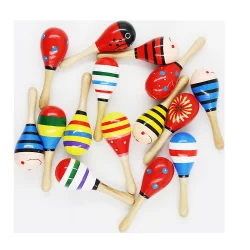How to Choose the Best Wooden Toys for Your Child: A Parent’s Guide
2024-08-12
Wooden toys are a fantastic choice for children, offering durability, safety, and endless opportunities for imaginative play. However, with so many options available, choosing the right wooden toys for your child can be a bit overwhelming. In this blog post, we’ll guide you through the key factors to consider when selecting wooden toys to ensure they are age-appropriate, safe, and engaging for your little one.
1. Consider Age-Appropriate Toys
When choosing wooden toys, it’s important to consider your child’s age and developmental stage. Different toys are designed to support various stages of development, from fine motor skills to problem-solving abilities.
- Infants (0-12 months): For infants, look for simple, safe toys like wooden rattles, teething rings, and stacking rings. These toys help develop hand-eye coordination and sensory skills.
- Toddlers (1-3 years): Toddlers benefit from toys that encourage exploration and movement, such as pull-along toys, shape sorters, and building blocks. These toys help with fine motor skills, cognitive development, and early problem-solving.
- Preschoolers (3-5 years): For preschoolers, opt for more complex toys like wooden puzzles, train sets, and pretend play sets. These toys encourage imaginative play, social skills, and early math and language development.
- School-Aged Children (5+ years): Older children can enjoy more intricate toys like construction sets, dollhouses, and board games. These toys support critical thinking, creativity, and teamwork.
2. Prioritize Safety
Safety is a top priority when selecting toys for young children. Wooden toys are generally safer than plastic toys, but there are still a few safety considerations to keep in mind:
- Non-Toxic Materials: Ensure that the toys are made from non-toxic, child-safe materials. Look for toys painted with water-based, non-toxic paints or natural finishes.
- Smooth Edges: Check that the toys have smooth, rounded edges and no small parts that could pose a choking hazard, especially for younger children.
- Durability: Choose well-crafted wooden toys that can withstand rough play without splintering or breaking. High-quality wooden toys are less likely to develop sharp edges or small pieces that could be dangerous.
3. Look for Educational Value
Wooden toys offer fantastic opportunities for learning through play. When selecting toys, consider those that provide educational benefits:
- Building Blocks: Wooden blocks are excellent for teaching basic concepts such as counting, sorting, and spatial awareness. They also encourage creativity as children build various structures.
- Puzzles: Wooden puzzles help children develop problem-solving skills, hand-eye coordination, and shape recognition. Puzzles with different levels of difficulty can grow with your child as they advance.
- Alphabet and Number Toys: Wooden toys that feature letters, numbers, and shapes are great for early literacy and math skills. Look for alphabet blocks, counting beads, or number puzzles to help your child learn through play.
4. Encourage Imaginative Play
Imaginative play is crucial for a child’s cognitive and social development. Wooden toys that encourage role-playing and creativity are always a good investment:
- Pretend Play Sets: Wooden play kitchens, tool benches, and dollhouses allow children to engage in role-playing, which fosters creativity and social skills.
- Vehicles and Figures: Wooden cars, trains, and animal figures are versatile toys that can be used in various imaginative scenarios. They also help children understand concepts like motion and cause and effect.
5. Choose Timeless Designs
One of the great things about wooden toys is their timeless appeal. When selecting toys, consider those with classic designs that will not only be enjoyed by your child today but also hold sentimental value for years to come:
- Classic Building Sets: Sets like wooden train tracks or building blocks are perennially popular and can be enjoyed by multiple generations.
- Heritage Toys: Look for toys with a nostalgic design, such as wooden rocking horses or traditional spinning tops, which can become cherished keepsakes.
Conclusion
Choosing the best wooden toys for your child involves considering their age, safety, educational value, and the potential for imaginative play. By selecting high-quality, timeless toys, you can provide your child with playthings that will not only entertain them but also support their development and create lasting memories. Wooden toys are a wonderful investment in your child’s growth, offering hours of fun and learning in a safe, natural, and sustainable way.



